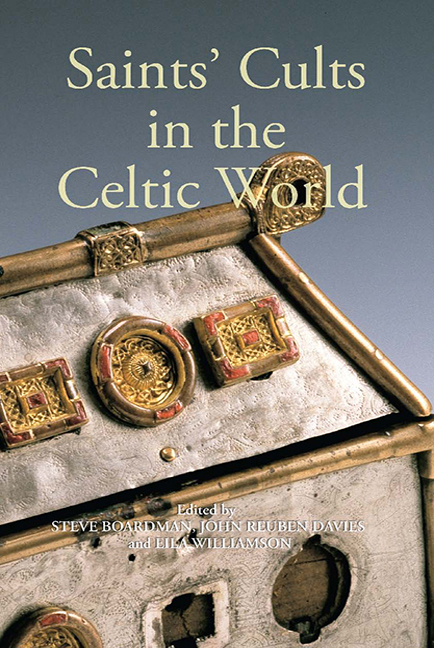Book contents
- Frontmatter
- Contents
- List of Illustrations
- List of Contributors
- Abbreviations
- Editors’ Preface
- 1 Rochester, Hexham and Cennrígmonaid: the movements of St Andrew in Britain, 604–747
- 2 The cults of Saints Patrick and Palladius in early medieval Scotland
- 3 Personal names and the cult of Patrick in eleventh-century Strathclyde and Northumbria
- 4 Bishop Kentigern among the Britons
- 5 Adjacent saints’ dedications and early Celtic History
- 6 Cuthbert the cross-border saint in the twelfth century
- 7 David of Scotland: ‘Vir tam necessarius mundo’
- 8 The cult of Saint George in Scotland
- 9 The cult of the Three Kings of Cologne in Scotland
- 10 The medieval and early modern cult of St Brendan
- General Index
- Miscellaneous Endmatter
5 - Adjacent saints’ dedications and early Celtic History
Published online by Cambridge University Press: 11 May 2017
- Frontmatter
- Contents
- List of Illustrations
- List of Contributors
- Abbreviations
- Editors’ Preface
- 1 Rochester, Hexham and Cennrígmonaid: the movements of St Andrew in Britain, 604–747
- 2 The cults of Saints Patrick and Palladius in early medieval Scotland
- 3 Personal names and the cult of Patrick in eleventh-century Strathclyde and Northumbria
- 4 Bishop Kentigern among the Britons
- 5 Adjacent saints’ dedications and early Celtic History
- 6 Cuthbert the cross-border saint in the twelfth century
- 7 David of Scotland: ‘Vir tam necessarius mundo’
- 8 The cult of Saint George in Scotland
- 9 The cult of the Three Kings of Cologne in Scotland
- 10 The medieval and early modern cult of St Brendan
- General Index
- Miscellaneous Endmatter
Summary
In 1986, Oliver Padel coined the phrase ‘recurrent adjacency’ to describe
a feature of Brittonic church dedications which has often been noted but never fully explained … Two saints with adjacent dedications in one country may often turn up, again adjacent, in another part of the Brittonic world … it is … a geographical dimension to the dedications of Brittonic saints, and one which has struck antiquarian writers from the Middle Ages to the twelfth century.
This ‘geographical dimension to the dedications of Brittonic saints’ was of particular interest to Gilbert Hunter Doble (1880–1945) and Emrys George Bowen (1900–1983), as well as, earlier on, to a range of Breton and Welsh scholars. The greatest nexus of clusters of ‘adjacent’ dedications is between Cornwall and Brittany (with some found also in Wales as well as in Devon). These two regions in particular are replete with notably obscure ‘saints’, often known only as church dedications or from place-names. Cults found across both regions are therefore all the more striking. Some of these shared cults may arise from early medieval emigration from Britain to Brittany. This is difficult to prove in specific cases while being a broadly reasonable assumption. Close contact between Cornwall and Brittany persisted, of course, through the medieval into the modern periods and may be responsible for later installations and conflations of saints’ cults.
The investigation of the geographical patterns of dedications to saints has changed considerably since the inspiring but perhaps somewhat naive work of Doble and Bowen. Their approach to patterns of dedications to saints as showing for the most part the movements of the saint himself or herself has been abandoned for more critical approaches. First, the dedications themselves are now somewhat more critically established according to linguistic and historical criteria. Second, they are viewed as a geographically and chronologically sensitive map of a cult over time. Only within this critical context are dedications related, if possible, to the actions of the saint in question, or to those of his immediate followers.
Place-names are a valuable category of evidence – and for Cornwall and Brittany invaluable, given the relative paucity of other types of evidence – especially for the cults of saints; but their primary, early character can be overstated.
- Type
- Chapter
- Information
- Saints' Cults in the Celtic World , pp. 91 - 118Publisher: Boydell & BrewerPrint publication year: 2009



